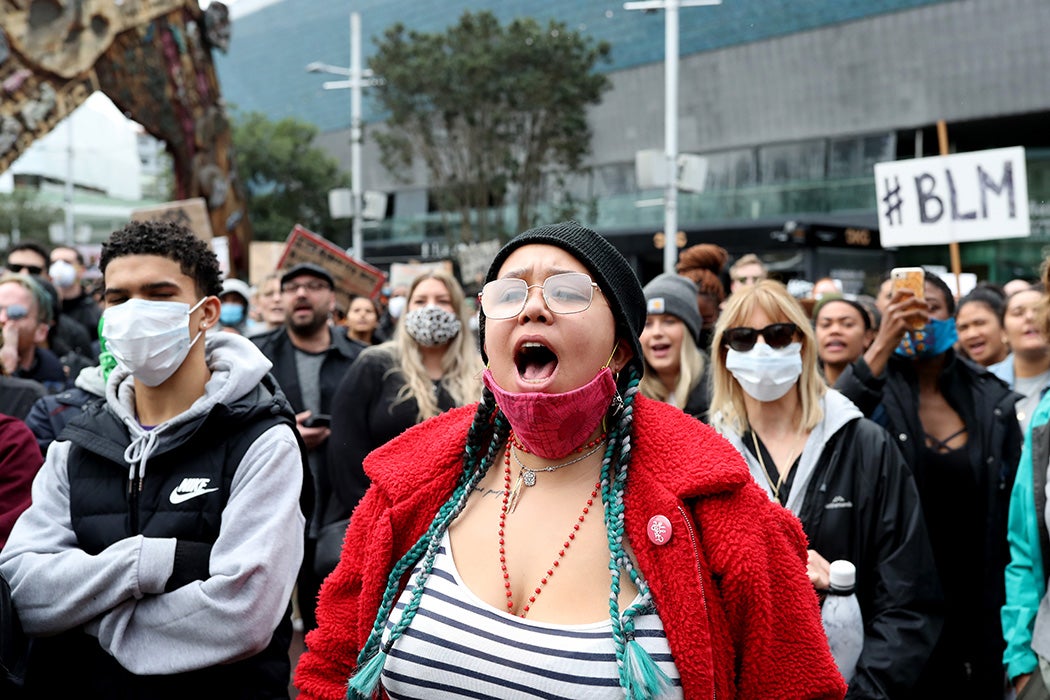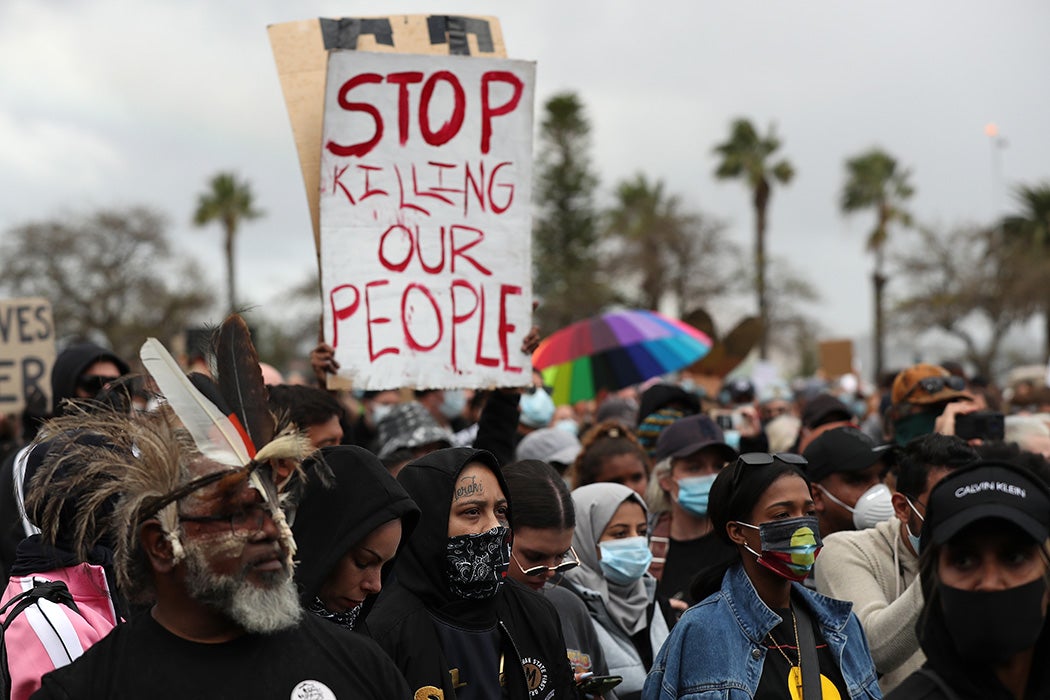Was there ever a Black power movement in the Pacific? Is there a sizable enough population of African descendants in the Pacific Islands to have started a Black power movement? These are reasonable questions if asked with the presumption that words like “Black,” “aboriginal,” “indigenous,” are immutable, that they are fixed categories to describe people. But they are not. As Barry Glassner, Emeritus Professor of Sociology at the University of Southern California, puts it, the meanings that people actually hold for words do not “develop outside of social processes.” Indeed, most social scientists “deny claims for the existence of inherent and essential characteristics of phenomena such as race, gender, and sexuality.” We cannot, quite simply, take the word “Black” for granted, as illustrated in the concept of “Black” that developed in the Pacific Islands in the latter half of the twentieth century.
During the late 1960s, people who today would be referred to as aboriginal activists self-identified as Black. They weren’t alone. In the late 1960s, the word “Black,” originally an epithet for aboriginal and African people, came to be known as an identifier for people of South Asian descent as well (in various countries across the world). People of Indian descent in places as far as South Africa joined Steve Biko’s Black consciousness movement. In Britain, they joined politically Black organizations. And in Guyana, Indians stood shoulder to shoulder with people of African descent and espoused the doctrine of Black power. They were encouraged to do so by African descendants like Walter Rodney.
The same was true for aboriginal peoples in the Pacific Islands, New Zealand, and Australia. They too at some point during the late 1960’s began to call themselves black. From New Caledonia to Tahiti to Papua New Guinea, a youth movement blossomed across the region, inspired by the Black Panther Party in the U.S., and by the calls by the Student Non-Violent Coordinating Committee for Black power and self-determination. Black power became the rallying cry of Pacific Islanders under European occupation, and indigenous peoples in Australia and New Zealand (as well descendants of Indian merchants and indentured servants).
Within the conception of Blackness that these indigenous peoples developed, there were no DNA tests: Polynesians, Melanesians, and others, unified under a category of Blackness that was political. The concept “Black” itself became incredibly flexible. And it was not difficult to see why: in the eyes of many Europeans, the people of the region were, indeed, Black.
As professor Quito Swan of Howard University argued in the Journal of Civil and Human Rights, Melanesians had endured “the persistent yarns of terms like New Guinea, blackfellas, kanaks, bwoys, cannibals, natives, blackbirding, monkeys, Melanesia, pagans, Papuans, pickanninies, and n-ggers” for centuries. To European observers, the indigenous peoples of the Pacific, New Zealand, and Australia were often described as being Black. They certainly did not care about any connections to African peoples when they called them that.

James Matla, an early settler of Australia in 1783, claimed that the land of the aboriginals was “peopled by only a few black inhabitants, who, in the rudest state of society, knew no other arts than such as were necessary to their mere animal existence.” And most certainly, when African descendants met people from the region, particularly the Melanesians, they wondered aloud if—as the ambassador, author, and diplomat Lucille Mair put it—they may have “shared a common ancestor” at some point. When Pacific Islanders identified as Black, furthermore, they found friends among many people of African descent.
As Swan writes, in 1974, Mildred Sope, a leading woman in the national liberation struggle of New Hebrides, was invited to attend the Tanzania Sixth Pan-African Congress on behalf of her independence struggle. As far as the Pan-African Congress was concerned, she was a Black sister and they had one struggle.
But perhaps Swan goes too far in claiming that what characterized Pacific Blackness was an attempt to hold onto “faded tints of a distant African providence.” Although these activists did appeal to the migration of their ancestors from Africa thousands of years ago, this was sometimes strategic. From a purely genetic perspective, the peoples of the Pacific islands in question were as distant to Africans as white Europeans. They were as African, in other words, as any human being.

This did not matter to Lachlan Macquarie, the man responsible for the Appin Massacre of Gundungurra and Dharawal people in what is now referred to as New South Wales, Australia. He insisted that nobody could argue against the “justice, good policy, and expediency of civilizing the aborigines, or black natives of the country.” The work of professor Stuart Banner is replete with references to a historical record where Aborigines and Black were interchangeable terms in the racial order of the time.
Genes and African ancestry never mattered to the racist settlers when it came to who and who wasn’t black. Black signified the inferiority of the Aboriginal Australian as it did to the African. Over time, the concept of being Black was assimilated by the natives. And so, when African Americans began to self-identify as “Black,” turning the word into one of pride, this resonated with the people of the pacific island region as well. And when they identified themselves not solely within the confines of Blackness, but indeed, with pan-Africanism and the Afro-French idea of Negritude, they weren’t rejected either.
In the Pacific conference in 1975, women fighting for the self-determination of the Pacific Islands spoke on the same stage as Hana Te Hemara, a Representative of the Maori Black power movement, Nga Tamatoa, from New Zealand. It was the same year that a radical ecological engineer, Kamarakafego from Bermuda, was deported from the New Hebrides by British and French officials because he was espousing “Black Power doctrines.” It must have come as a surprise for the police force to find themselves fighting protesters, trying to block a plane from leaving their tiny island while screaming Black power.
The Black Power movement spread across the whole region. The historian Kathy Lothian has written extensively on the Black Panther Party of Australia, which joined the Black Panther Movement, the Black Beret Cadre of Bermuda, and the Dalit Panthers of India, forming an international offshoot of the movement that was started by Bobby Seale and Huey Newton in Oakland, California. In 1969, many of the very same activists who found it more strategic to appeal to an aboriginal identity for land rights were, in fact, members of the Black Panther Party.
Weekly Newsletter
The Victorian indigenous activist Bruce McGuinness urged all aboriginal people to buy Stokely Carmichael and Charles Hamilton’s Black Power, to take one example. Denis Walker, a founder of the Australian Black Panther Party, had all members of his movement read Black political theorists like Fanon, Malcolm X, and Eldridge Cleaver for at least 2 hours each day. Generations later, in Guyana, Britain, Australia, New Zealand, and the Pacific Islands, many young indigenous people, and many young people of Indian descent, are growing up oblivious to the fact that some of their grandparents used to call themselves Black.
Is the question more controversial now than it was back then? Do these indigenous activists get to be incorporated into the canon of the Black radical tradition? At least in England, when it comes to political Blackness among people of East Asian and North African descent, the question likely won’t be settled soon. Even though many young people may reject these expansive definitions of Blackness, what is certain is that the word “Black” hasn’t always existed in the way we understand it today.
Support JSTOR Daily! Join our new membership program on Patreon today.







